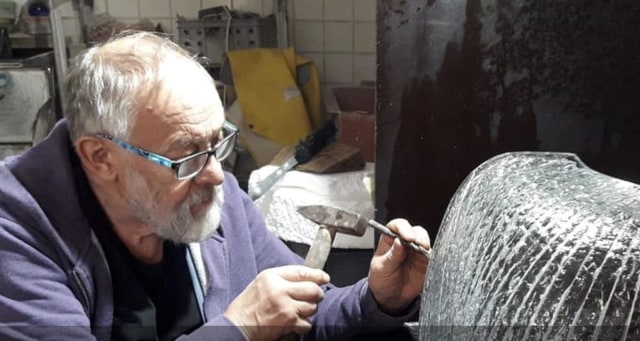Vladimir Klein, born in Czechoslovakia in 1950, studied at the Academy of Applied Arts in Prague under the noted Czech glass artist Stanislav Libensky. Klein taught and subsequently directed at the glassmaking school in Kamenicky Senov for fourteen years and served as a visiting professor at the prestigious Toyama Institute of Glass Art in Japan which has since become a major hub for artists from the “Heart of Europe”.
Klein also spent nine years as the chief designer for major utility glassmaker Crystalex. He has received many awards for his glass sculptures, which are exhibited in public collections around the world. He has also presented solo exhibitions in the Czech Republic, Germany, the Netherlands, Turkey, Japan and the USA.
Globally renown, Vladimir Klein creates his objects using a unique and challenging technique which he developed himself, involving the use of a hammer and chisel. He frequently combines the resultant surface structure with perfectly polished surfaces, creating a play of lights which fills his objects with life.
One of the most notable factors in the field of Czech glass art is that each generation produces new creative talent able to generate interest not just among the critics, but also among art lovers and collectors.
Despite his considerable theoretical and practical skills and knowledge working with glass for more than half a century, Vladimir Klein hasn’t come close to recycling past ideas. Rather, his insatiable appetite for creation flows as powerfully as the Danube through the artist’s birthplace back in 1950, namely the Slovak town of Komarno. Indeed, perhaps the clear water, rugged riverbed, and irregular riverbanks dotted with grass and reeds have served as a subconscious inspiration for Klein’s glass art creations.
Would you call your work a craft or art?
I have three criteria for everything I do in my life: what I do, how I do it, and why I do it.
If I only master skills, I can imitate things. If I do it well, I'm a good artisan. If I know why I do it, I create meaning, an idea – then it is art!
Why glass?
There's no other material that allows you to express abstract themes so well. With its glitter, transparency, reflections and other specific luminescent traits, you can materialise the immaterial.
What techniques do you use the most?
As well as traditional engraving and cutting, I apply stone sculpting techniques on my sculptures. I use a chisel and hammer, and I grind and polish the glass with a flexible shaft grinder. So the whole process consists of the object remaining still and me moving around it.
It sounds a little risky…
It's quite an adventure. Working with glass in its cold state boosts adrenalin because a crack can spoil everything. But setbacks are useful too. I recycle the material or use parts of it cut with a waterjet. It's economical, and the accidental shapes are inspiring.
What’s the most memorable experience of your career?
In 1991 I was invited to teach at the Institute of Glass Art in Japan. I found myself in utterly new conditions. I was overwhelmed by the foreign language, culture and environment. So art became my main means of communication. Thanks to it, I evolved like a child!
